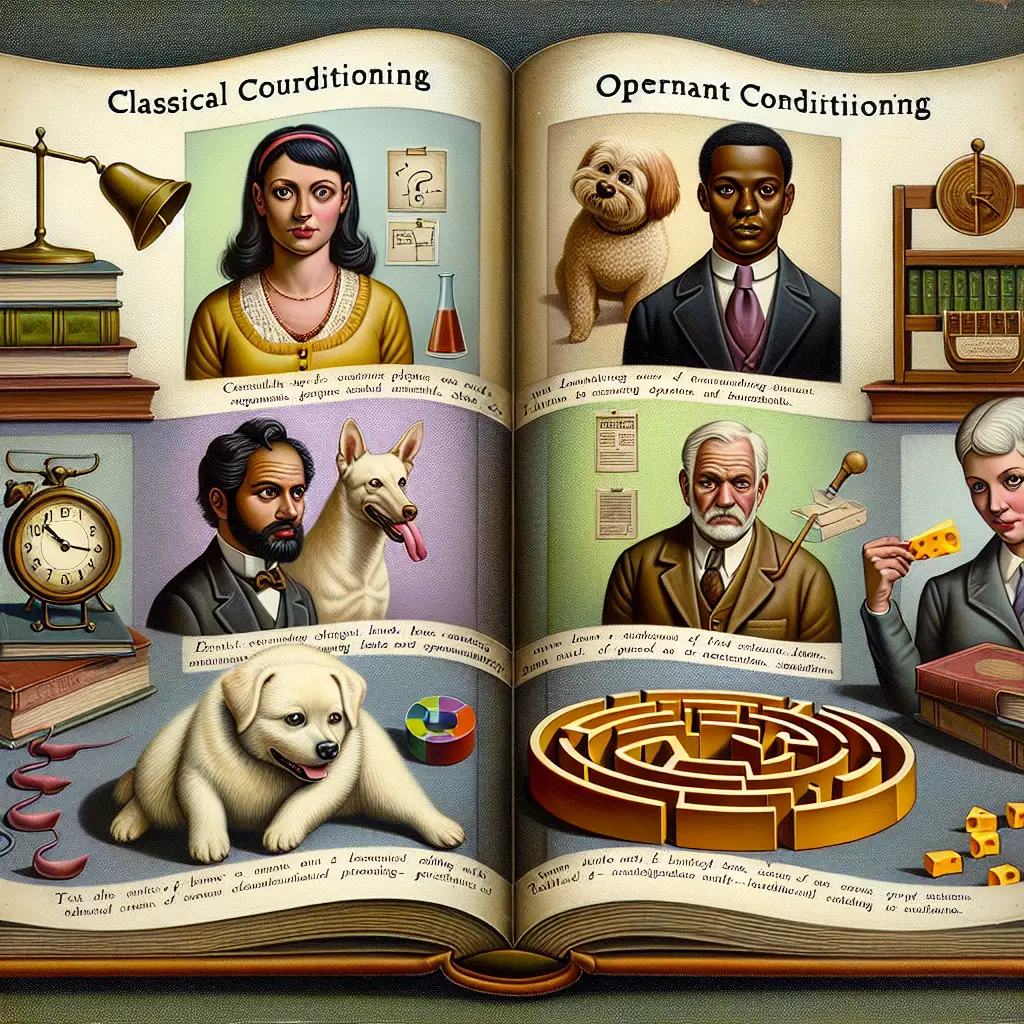
Learning Styles Unveiled: The Distinct Mechanics of Classical and Operant Conditioning
Introduction
In the rapidly evolving landscape of education and psychology, the discussion surrounding learning styles and how they impact our ability to absorb information has never been more pertinent. With countless theories and models proposed over the years, one critical area often overlooked is the interplay between classical and operant conditioning. Learning Styles Unveiled: The Distinct Mechanics of Classical and Operant Conditioning is not just an academic exercise; it provides invaluable insights that can transform our understanding of how we learn and apply knowledge in various settings.
In this engaging exploration, we will delve into the core principles that govern these two foundational theories of learning. Through case studies, practical applications, and clear visual aids, we aim to not only clarify the distinct mechanics of these conditioning types but also provide actionable insights that readers can apply in their own learning or teaching journeys.
The Essence of Learning Styles
Before delving into the specifics of conditioning, it’s crucial to contextualize Learning Styles Unveiled: The Distinct Mechanics of Classical and Operant Conditioning within the broader framework of learning. The notion of learning styles—visual, auditory, kinesthetic, and more—has gained traction among educators and learners alike. Yet, the efficacy of tailoring learning experiences to these styles has been debated.
The Debate Surrounding Learning Styles
Critics argue that while individual preferences exist, most people can learn through various modalities. On the other hand, proponents advocate that recognizing and leveraging these styles can enhance educational outcomes. Regardless of where one stands in this debate, understanding how classical and operant conditioning affects learning styles can elucidate how we can adapt our approaches for maximum effectiveness.
Classical Conditioning: The Foundation of Association
Understanding Classical Conditioning
Classical conditioning, first identified by Ivan Pavlov through his experiments with dogs, is predicated on the idea of association. In a simplified form, it involves pairing a neutral stimulus with an unconditioned stimulus to elicit a conditioned response. This foundational mechanism plays a vital role in how we form connections and associations throughout our learning experiences.
Key Mechanisms of Classical Conditioning
-
Unconditioned Stimulus (US): This naturally evokes a response. For instance, food triggers salivation.
-
Conditioned Stimulus (CS): Initially neutral, this becomes associated with the unconditioned stimulus. For example, a bell rings before feeding the dog.
- Conditioned Response (CR): The learned response to the conditioned stimulus. In Pavlov’s case, the dog salivates upon hearing the bell, even without food present.
Real-World Application of Classical Conditioning
A practical example of classical conditioning can be seen in the classroom setting. Consider a teacher who plays a specific piece of music before each math lesson. Over time, students begin to associate this music with learning math, leading to heightened focus and preparedness when they hear it.
| Stimulus | Type | Response |
|---|---|---|
| Food | Unconditioned Stimulus | Salivation |
| Bell | Conditioned Stimulus | Salivation upon hearing the bell |
| Music | Conditioned Stimulus | Increased focus during math lessons |
Case Study: The School Environment
A study conducted in elementary schools demonstrated that teachers who used specific visual aids (conditioned stimuli) during lessons were able to enhance students’ recall of information. When paired with positive reinforcement (stronger recall due to conditioning), the results highlighted how classical conditioning can effectively impact learning outcomes.
Operant Conditioning: Shaping Behavior Through Consequences
Understanding Operant Conditioning
Coined by B.F. Skinner, operant conditioning diverges from classical conditioning in that it emphasizes the role of reinforcement and punishment in shaping behavior. The mechanics involve the use of consequences to influence the likelihood of a behavior occurring again.
Key Components of Operant Conditioning
-
Reinforcements: These can be positive (adding a pleasant stimulus to encourage behavior) or negative (removing an unpleasant stimulus).
- Punishments: These can also take a positive form (adding an unpleasant consequence) or a negative form (removing a pleasant stimulus).
The Classroom Through the Lens of Operant Conditioning
In educational settings, operant conditioning can dramatically influence student behavior. For instance, a teacher might implement a system of rewards to encourage participation. A child who answers questions correctly could receive a sticker, serving as a positive reinforcement that strengthens the likelihood of future participation.
| Behavior | Type | Consequence |
|---|---|---|
| Correct answer | Reinforcement | Obtaining a sticker |
| Disruptive behavior | Punishment | Loss of recess privileges |
Case Study: Reward Systems in Schools
A notable case study from a middle school demonstrated that implementing a point-based reward system improved student engagement and academic performance. Teachers who integrated a structured reward system reported a marked increase in participation and homework completion, showcasing the effectiveness of operant conditioning.
Bridging the Gap: Integrating Conditioning in Learning Styles
The Intersection of Classical and Operant Conditioning
While classical and operant conditioning serve distinct purposes, their integration provides a comprehensive framework for understanding learning styles. Tailoring teaching methods can lead to more effective educational experiences by aligning with these conditioning principles.
Practical Application in Diverse Learning Contexts
-
Visual Learners: Utilize images (classical conditioning) while rewarding engagement in visual activities (operant conditioning).
-
Auditory Learners: Combine sound cues (classical conditioning) with praise for contributions (operant conditioning).
- Kinesthetic Learners: Engage students in movement-based exercises (classical conditioning) that are followed by rewards for participation (operant conditioning).
Actionable Insights: Crafting Effective Learning Environments
Creating a Resilient Learning Framework
To create effective learning environments, educators and learners must consider combining elements of both classical and operant conditioning in their strategies. Here are some actionable insights to consider:
-
Establish Strong Associations: Create consistent pairings of stimuli and experiences to enhance recall and engagement.
-
Implement Reward Systems: Develop a multi-tiered reward system that recognizes various levels of achievement and participation.
- Personalize Learning Experiences: Cater to different learning styles while maintaining a core focus on the classical and operant principles of conditioning.
Conclusion
As we explore this intricate interplay, Learning Styles Unveiled: The Distinct Mechanics of Classical and Operant Conditioning serves as more than an academic exploration; it’s a call to action. By understanding how classical and operant conditioning shape learning experiences, we can craft educational strategies that are not only more effective but also more inclusive.
In an age where adaptability is crucial, embracing these principles can empower educators, students, and lifelong learners alike to navigate the complexities of knowledge acquisition with greater confidence. As you reflect on your learning journey, consider how you can apply these insights to optimize your educational experiences or those of others around you.
FAQs
Q1: What are the major differences between classical and operant conditioning?
A1: Classical conditioning focuses on the association between two stimuli and does not involve reinforcement, while operant conditioning is based on the consequences of behavior—reinforcement or punishment—that influence future behavior.
Q2: How can understanding these conditioning types improve educational methods?
A2: By leveraging both classical and operant conditioning principles, educators can create a more personalized and effective learning environment that caters to various learning styles.
Q3: Can learning styles be classified more effectively through classical and operant conditioning?
A3: Yes, understanding these conditioning mechanisms can provide deeper insights into how and why certain learning styles are more effective in specific contexts.
Q4: What are some examples of positive reinforcement in educational settings?
A4: Positive reinforcement can include verbal praise, stickers, extra playtime, or any rewards that encourage desired academic behaviors.
Q5: Are there downsides to relying too much on conditioning strategies?
A5: While conditioning can be effective, over-reliance on rewards or punishments may lead to extrinsic motivation taking precedence over intrinsic motivation. A balanced approach is critical.
By synthesizing these concepts, the insights within Learning Styles Unveiled: The Distinct Mechanics of Classical and Operant Conditioning can forge pathways to more effective, engaging learning experiences. This integrated approach encourages all learners to thrive in educational environments that resonate with their unique styles of learning.
















